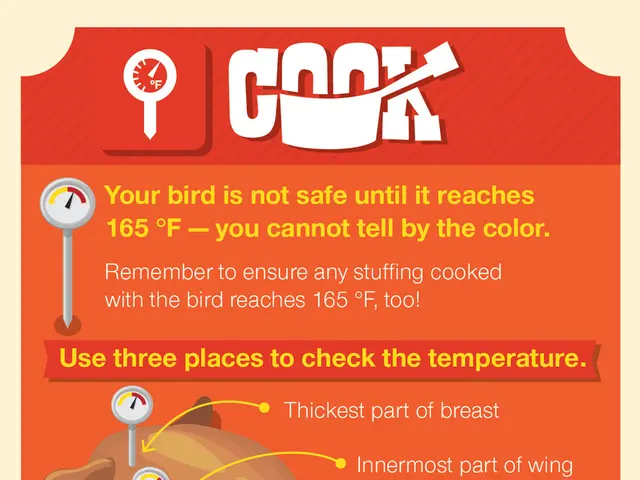Reclaiming Your Relationship with Food: A Science-Backed Guide to Resetting Your Taste Buds and Eliminating Cravings
Transforming Your Taste Preference: A Comprehensive Blueprint for Breaking Free from Processed Food Addiction
In today's fast-paced world, many of us have found ourselves overindulging in unhealthy foods, leading to unsatiable cravings and a strained relationship with our diet. To help navigate this complex issue, we've compiled a comprehensive guide that combines scientific strategies and practical steps to empower you to reset your taste buds, break free from junk food cravings, and cultivate a healthier relationship with food.
The Science Behind Unhealthy Cravings
Before delving into how to reset your taste buds, it's crucial to understand why we crave unhealthy foods. Cravings are a complex interplay of our biology, psychology, and environment, and their origins can be traced back to the release of dopamine, a neurotransmitter associated with pleasure and reward (National Center for Biotechnology Information, 2023). When we consume junk food, particularly those high in sugar, salt, or fat, our brain is flooded with dopamine, creating a sensation of happiness or satisfaction that reinforces our desire to consume these foods (Haan & Steptoe, 2017). Over time, this creates a cycle that is notoriously challenging to break, as our brain continuously seeks the pleasurable sensation offered by unhealthy foods (Avena et al., 2008).
Sugar: The Enemy Within
One of the primary culprits behind unhealthy cravings is sugar. Consuming sugar-rich foods triggers a spike in blood sugar levels, followed by a subsequent drop that leaves us feeling lethargic and once again craving something sweet to boost our energy. Over time, this repetitive cycle creates a dependency on sugar to regain that quick energy boost (Rosch, 2021). Furthermore, highly processed foods laden with refined sugars, unhealthy fats, and preservatives can manipulate our taste buds, training them to crave intense flavors, making it increasingly challenging to appreciate the subtle flavors of whole, unprocessed foods (Rosch, 2021).
How Taste Buds Work: The Building Blocks of Flavor
Taste buds play a vital role in determining what foods we find appealing. They transmit signals to the brain, which interprets these signals as flavors. The ability to understand how taste buds function can aid in resetting our cravings. Located on the tongue, taste buds are specialized cells that detect five primary tastes: sweet, salty, sour, bitter, and umami. By eliminating junk food from our diets and introducing healthier options, we have the opportunity to recalibrate our taste buds (Guerrero-Legarreta & Conner, 2020).
Taste Bud Renewal: A Fresh Start for Your Palate
Taste buds naturally regenerate every two weeks. This continuous process provides a unique opportunity to reset our taste buds by eliminating junk food from our diet and introducing healthier options (Guerrero-Legarreta & Conner, 2020). By adopting clean eating habits, we enable our taste buds to re-establish their sensitivity to natural flavors, effectively curbing cravings for unhealthy foods.
A Clean Eating Reset: Taking Control of Your Food Choices
Taking action to reset your taste buds and stop unhealthy food cravings involves several steps. The first step is to eliminate processed foods from your diet. Choosing whole, natural foods like fruits, vegetables, lean proteins, and whole grains is essential, while being mindful of food labels and avoiding those filled with artificial ingredients (Martin & Fothergill, 2020).
Replacing high-calorie, low-nutrient food items with healthier alternatives by gradually reducing junk food consumption and increasing nutritious options is another essential aspect of the clean eating reset (Martin & Fothergill, 2020). A gradual approach helps your body and mind adjust to the transition, making the process more sustainable.
Psychological Strategies: Taming the Cognitive Beasts
Cravings are not only physical but also psychological. To effectively combat them, it's essential to address the emotional and mental factors that contribute to unhealthy food choices (Macht, 2012). Mindful eating, which involves focusing on hunger cues and savoring each bite, is an effective technique for overcoming cravings. By practicing slow, deliberate eating, we can become more in tune with our bodies' needs, promoting self-awareness and reducing mindless snacking (Macht, 2012).
Stress management is another critical component in managing unhealthy food cravings. Some effective ways to alleviate stress and combat emotional eating include meditation, yoga, deep breathing exercises, and journaling (Baer, 2009). Learning to cope with stress in healthy ways can help mitigate the urge to turn to food for comfort.
The Power of Hydration: Quenching Your Cravings
Many unhealthy food cravings are actually masked thirst signals. Combat dehydration by incorporating water and hydrating foods into your daily routine. Hydration helps regulate your appetite, curb cravings, and support overall health (Popkin et al., 2010).
Protein and Fiber: The Duo Effect
Protein and fiber play integral roles in satiety. By incorporating foods rich in both proteins and fibers, we can transition from craving junk food to feeling satisfied after healthy meals. Proteins aid in maintaining fullness, while fibers slow digestion and curb spikes in blood sugar levels, effectively reducing cravings (Das, 2014).
A Healthy Gut Microbiome: The Untapped Key to Craving Control
Recent research has suggested that the composition of our gut microbiome can significantly influence our food preferences, including cravings for unhealthy foods (Karl, 2021). Populating our gut with beneficial bacteria and reducing unfavorable bacteria is crucial in resetting our cravings. Consuming probiotics, prebiotics, and fiber can support a healthy gut microbiome and further aid in reducing unhealthy food cravings (Karl, 2021).
Sleep's Impact on Cravings
Quality sleep is essential to maintaining a healthy weight and regulating cravings. When we don't receive adequate sleep, our brain produces more of the hormone ghrelin, which increases hunger, and less of the hormone leptin, which tells us we're full. This hormonal imbalance can increase our desire for high-calorie, unhealthy foods (Van Cauter et al., 2010). Prioritizing restful sleep can help regulate these hormones and combat unhealthy food cravings.
The Benefits of a Clean Eating Reset: A Brighter Future
Embarking on a clean eating reset can yield several benefits. In addition to reducing cravings, this lifestyle change can lead to increased energy, improved digestion, better skin, and even improved sleep quality (Rosch, 2021). Over time, you may find that you can appreciate the natural flavors of fruits, vegetables, and whole grains once again, effectively breaking the cycle of unhealthy cravings.
Embracing the Lifestyle Shift
To maintain the benefits of your clean eating reset, it's essential to make this lifestyle change sustainable. Start with achievable goals, plan meals in advance, immerse yourself in a supportive community, and remain patient with yourself. Each step towards cleaner eating brings you one step closer to a healthier, happier you.
Exercise: A Powerful Ally in the Battle Against Cravings
Regular exercise plays a crucial role in reducing cravings and maintaining a healthy metabolism. Physical activity helps regulate hunger hormones, boosts energy levels, and improves mood, all of which make it easier to stick to a clean eating routine (Hacks et al., 2014). Incorporating both cardiovascular exercise and strength training into your exercise regimen is advisable for optimal results.
Overcoming Social and Environmental Triggers
We've all faced situations where social gatherings or environmental cues tempt us into indulging in unhealthy foods. To combat this, bring healthy snacks to share at social events, opt for healthier menu options when dining out, and remain confident in your clean eating choices. At home, create a junk-free environment by stocking your kitchen with wholesome foods and removing temptations from your pantry (Rosch, 2021).
By understanding the science behind cravings, implementing practical steps, and making lasting lifestyle changes, you can redefine your relationship with food, unlocking a world of health and vitality.
- In the fast-paced world we live in, many of us find ourselves overindulging in unhealthy foods, leading to unsatiable cravings and a strained relationship with our diet.
- Before delving into how to reset your taste buds, it's crucial to understand why we crave unhealthy foods - cravings are a complex interplay of our biology, psychology, and environment, and their origins can be traced back to the release of dopamine.
- Unhealthy food cravings are notoriously challenging to break due to the cycle created by our brain continuously seeking the pleasurable sensation offered by junk food.
- One of the primary culprits behind unhealthy cravings is sugar, as consuming sugar-rich foods triggers a spike in blood sugar levels followed by a subsequent drop, resulting in continued cravings for something sweet to boost energy.
- Located on the tongue, taste buds play a vital role in determining what foods we find appealing, and understanding how they function can aid in resetting our cravings.
- Taste buds naturally regenerate every two weeks, providing a unique opportunity to reset our taste buds by eliminating junk food from our diets and introducing healthier options.
- Adopting clean eating habits, such as choosing whole, natural foods like fruits, vegetables, lean proteins, and whole grains, is essential in enabling taste buds to re-establish their sensitivity to natural flavors.
- Practicing mindful eating, stress management techniques like meditation, yoga, and deep breathing exercises, and staying hydrated can aid in reducing unhealthy food cravings.
- Protein and fiber play integral roles in satiety: incorporating foods rich in both can help transition from craving junk food to feeling satisfied after healthy meals.
- Recent research suggests that the composition of our gut microbiome can influence our food preferences, making populating our gut with beneficial bacteria and reducing unfavorable bacteria crucial in resetting our cravings.
- Quality sleep is essential to maintaining a healthy weight and regulating cravings, as poor sleep can increase our desire for high-calorie, unhealthy foods.
- Regular exercise plays a crucial role in reducing cravings and maintaining a healthy metabolism, as physical activity helps regulate hunger hormones, boosts energy levels, and improves mood, making it easier to stick to a clean eating routine.








